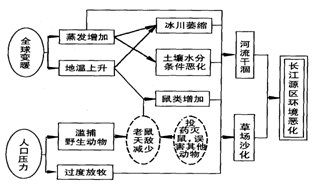图示为长江源区环境恶化过程示意,试从自然和人类活动两个方面概述长江源区环境恶化的原因,并提出防治的建议。

从自然条件方面看,全球变暖是主要原因。由此导致蒸发增加和地温上升,使河流的补给(冰川融水、土壤水)每况愈下,导致部分河段干涸,环境恶化。
在人类活动中,滥捕滥猎野生动物,使生态平衡遭到破坏;鼠害日益严重,以及过度放牧,是破坏草原、造成草场沙化的两大因素。
制止对有益野生动物的滥捕滥猎,加强草原建设,提高畜牧业管理水平,是防止该区环境进一步恶化的主要措施。
本题考查区域生态破坏。直接利于图示的环境恶化关系图概括;自然原因主要以全球变暖为背景;人为原因主要由于人口压力大,不合理的人类活动引起。防治措施主要针对不合理的人类活动方面分析。
